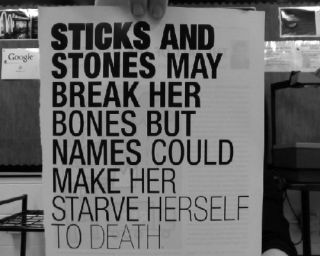Anxiety
Eleven Ways REBT Can Help Anorexia
REBT may help people with Anorexia to feel better and get better.
Posted June 23, 2014

REBT may teach people with anorexia a new way to address emotional distress.
Each day that goes by in the life of a person with anorexia reveals the snowballing effect of believing stressful thoughts. The thoughts that contribute to the development of anorexia worsen as the condition progresses, unless people with anorexia can be helped to view their thinking, emotions, behaviors, and condition very differently.
Due to the high risk of health problems that can develop from malnutrition (including cardiac conditions, osteoporosis, endocrine disorders, and others) and due to the heightened risk of mortality related to the effects of anorexia, interdisciplinary treatment is not only strongly recommended but is often essential for treatment success.
While nutritional stabilization is always a priority, the layers of irrational beliefs and self-defeating behaviors are daily concerns, since these can always lead to the worsening of the condition, or later relapse. In addition, it is noteworthy that about half of people with anorexia also suffer from depression. Other mental disorders, such as addictions, anxiety disorders, and bulimia are also more likely to be present in a person with anorexia than in a person who doesn’t have it.
Why include Rational Emotive Behavior Therapy (REBT) in recovery from anorexia?
- REBT is designed to be a portable, relatively easy to learn, and versatile therapy, with interventions and philosophical positions that can help. REBT can be used in conjunction with other methods for daily recovery, as the disordered thinking that accompanies this condition sometimes allows restructuring.
- The multiple false inferences that people with anorexia tend to draw lend themselves to using REBT in developing new, more effective ways of viewing the familiar challenges that people with anorexia face.
- Because anorexia is so stubborn for many of its victims, the same tenacity that supports the eating disordered thinking and behavior can be redirected toward defeating it. Because REBT advocates daily and ongoing strong, forceful, and stubborn disputing of stressful thoughts, it provides a match for the beliefs of anorexia to be chipped away at and overwhelmed.
- When a person gains receptivity to recovery, and when they become receptive to utilizing various strategies for self-support, then REBT can become a best friend.
- REBT’s emphasis upon unconditional self, other, and life acceptance provides a person with anorexia with a philosophical structure to help him or her address the underlying demands which generate so much of the disordered patterns.
- Moreover, REBT can help individuals with this condition to develop a healthier life philosophy overall, supporting life-style balance beyond recovery. The emphasis upon the development of a vital absorbing interest can help the person with anorexia to redirect their focus away from food and bodies, and toward the development of something which is stimulating and life enhancing.
- Dr. Albert Ellis, the founder of REBT, often emphasized that REBT is a unique therapy in that it is designed to help people not just to feel better but also to get better. Indeed in the case of anorexia, a condition that requires people to develop an entire new relationship with food and their bodies, getting better is most crucial!
To utilize REBT, it is helpful to be aware of some of the common irrational beliefs and maladaptive behaviors that are prevalent in the anorexic disorder. Below are eleven ways to apply REBT to help individuals to disrupt their thinking/emoting/behaving cycles:
- Labeling a person versus labeling their behavior. A person with anorexia is a person first. Their condition does not define them, even though body concerns and food may be their focal interests at various points in the disorder.
- Self-downing and self-labeling. People with anorexia often criticize themselves. REBT teaches unconditional self-acceptance and a movement away from rating the entire self based upon singular dimensions. Because the “self” is multi-faceted and ever-evolving, it cannot be reduced to a single rating upon a single dimension (such as fat-thin). In addition, because people with anorexia distort their body image, their rating of themselves is also based upon distorted perception. Since REBT advocates scientific thinking, a distorted perception is seen as a faulty measuring device, and doesn’t meet the scientific criterion of reliability or validity. =Additionally, Dr. Albert Ellis taught his patients to think in terms of, “It is bad,” not “I am bad.”=Unconditional Self Acceptance (USA) may be the greatest daily practice of the person with anorexia, simply because self-downing pervades his or her daily life (in front of the mirror, while eating, in social comparison, and more).=Learning to accept one’s self as a fallible human can offer great advantages when facing these triggers for self-downing. Rational Emotive mirror work can be used to help the person to accept one’s body as well.
- Replacing social comparison with Unconditional Other/Life Acceptance. People with anorexia are practiced in social comparison, and they often become expert in finding ways to fall short of the mark. While USA (already discussed in #2) can be practiced, it is also helpful to learn Unconditional Other Acceptance (UOA) and Unconditional Life Acceptance (ULA). UOA might include a recognition that each person is seeking happiness, health, connection, and fulfillment, but each person is also acceptable as a fallible human. ULA can help a person with anorexia to practice ideas which recognize the randomness of various aspects of life; for example, just as some people are born into more advantageous life conditions without regard to fairness, this is also true of body differences. Thus, USA, UOA, and ULA can help people with anorexia to move away from rating the self, others and life circumstances based upon single dimensions. These forms of acceptance fight anorexic rating with reality, because people are multifaceted and ever-evolving, because life is not a contest, and because unfairness exists as a part of reality.
- Ego anxiety. REBT can help people with anorexia to address their anxiety about appearing “less than” their ideal image or less than what they think others demand for their bodies. One approach may include having the person list the Pros & Cons of holding onto the demand for an ideal body versus releasing this demand. Dr. William Knaus offers three steps to combat anxiety which can be applied here as well.
- Discomfort anxiety. REBT can help people to address their anxiety around appearing fat or feeling body cues which are defined as “feeling fat”. In addition to helping people with anorexia to appropriately label their emotions, leading to greater emotional self-understanding, REBT teaches people to tolerate distress. Since anorexia leads people to avoid emotional/physical discomfort related to eating appropriately sized portions, REBT helpfully teaches people to face these feelings by employing a variety of strategies for coping with their discomfort. For example, a person with anorexia might be encouraged to avoid a food ritual and tolerate the anxiety around abstaining from the ritual. She might also be encouraged to tolerate eating more than is comfortable in order to learn to tolerate her physical discomfort related to eating normally. Since almost half of the individuals with anorexia add in bulimic behaviors as the condition worsens, the tolerance of this discomfort may prevent this progression. Coping statements such as, “Even though I don’t like it, it is not a catastrophe to feel mild pain. This feeling will pass in time,” can help the person to relax and cope instead of panic.
- Low Frustration Tolerance (LFT) versus High Frustration Tolerance (HFT). REBT would encourage the individual with anorexia to start questioning whether he or she wants to continue to have the short-term relief and associated long-term negative consequences versus short-term frustration accompanied by longer-term fulfillment, health, and life-balance. For example, an individual might opt to avoid the frustration of life by restricting during a meal, rather than problem-solving through life’s challenges. They might use LFT phrases such as, “I can’t stand my problem,” to describe how it feels for them to tolerate such challenges without restricting. REBT can teach individuals to raise their frustration tolerance, developing HFT practices and coping phrases such as, “I don’t like it but I can stand it; it is better for me in the long run to learn how to problem-solve, even if I don’t like how it feels now.”
- Body dysmorphia. Some people with anorexia see a reflection that does not match the view of others around them. While others urge the person to gain weight, the person with anorexia looks in the mirror and wonders why others don’t see what he or she sees. While the mechanism for body dysmorphia isn’t clear, contributors might include nutritional deprivation of the brain, hyper-focusing upon the body, and contingencies of reinforcement (such as degrading statements or reinforcing statements which provoke weight loss). Using REBT might not change the perception of the person with anorexia; but, perhaps it can be used to help the person to understand that despite what he or she sees in the mirror, others perceptions do not agree with their own, and it is not necessary to demand a particular body image in order to be human. REBT might serve to erode unhealthy self-statements related to body dysmorphia, leading to eventual re-interpretation of what she views in the mirror.
- Mind-reading and fortune telling. REBT can help people with anorexia to challenge the inferences that others are viewing them critically or that they are destined to be humiliated by others if they don’t restrict. In addition, REBT can address the underlying demand that others must not view them critically or express disapproval.
- Modified shame attacking. REBT advocates feeling (rather than avoiding) shame and then addressing the underlying beliefs that lead to shame. People with anorexia may be very ashamed to eat in front of others who are either not eating or eating less than they are. When appropriate, very gradual exposure to these shameful situations combined with Rational Emotive Imagery can help to both desensitize the person to her shame and restructure beliefs that lead to shame in these situations, allowing the person with anorexia to improve eating flexibility in social situations.
- Self versus Social Interest Imbalance. REBT advocates a balance between self-interest and social-interest. At some points, the person with anorexia may give too much emphasis to the opinions of others. At other points, the same person may become very self-absorbed, spending a significant portion of time examining his or her body or reflection. REBT may help a person to recognize that he cannot control the opinions of another. It might also help the person with anorexia to challenge the idea that spending time in obsessive self-examination is useful or helpful to him in life. Additionally, REBT would encourage the person to invest in endeavors that promote the welfare of the self as well as the welfare of others, rather than focusing upon endeavors that serve neither.
- Non-perfectionism. All-or-nothing thinking, combined with perfectionistic standards, plague the thinking of the person with anorexia. Dr. Ellis said, “Perfectionism normally limits your possible solutions to a problem and induces you to solve it much less ‘perfectly’ than you otherwise would if you were not perfectionistic.” REBT teaches patients to strive for satisfaction in the midst of imperfection, and to look for what is good and useful, rather than seeking flawlessness.
While these are just a few of the ways REBT can help those with anorexia, it is by no means exhaustive nor sufficient! However, those who treat people with anorexia, and the individual with anorexia, may find that the philosophical tenets of and daily use of REBT can support an overall comprehensive, interdisciplinary treatment plan. While Dialectical Behavioral Therapy and other Cognitive Therapies are commonly used in treatment, REBT offers unique philosophical angles which might be particularly useful to also teach this population, in conjunction with these and other therapies.
For more information on self or group teaching of REBT, check out The REBT Super-Activity Guide: 52 Weeks of REBT for Clients, Groups, Students and You.
REBT based recovery groups, such as SMART Recovery, work on motivation, urges, emotional regulation, and lifestyle balance can be address recovery issues. Websites which provide REBT self-help forms, such as REBTNetwork, can help those learning REBT to practice applying it to overcoming life’s challenges.


